
(13 - 20 April 2015)
Ice drift
Week 33 of ice drift was a period of no motion followed by a period of unusually fast drift. The ice in the region of the camp moved only a few tens of meters between Sunday 12 April and the morning of Wednesday 15 April (Fig. 1), while the drift during the rest of the week was 37 nautical miles (68 km). The maximum speed was 0.8 knot. The driving force was a low pressure that moved across Greenland from south to north in twelve hours on Wednesday 15 April and became stationary near the North Pole for the rest of the week (Fig. 2). Winds were over 20 knot from Saturday morning and 30-40 knot on Sunday with gusts to over 50 knot.
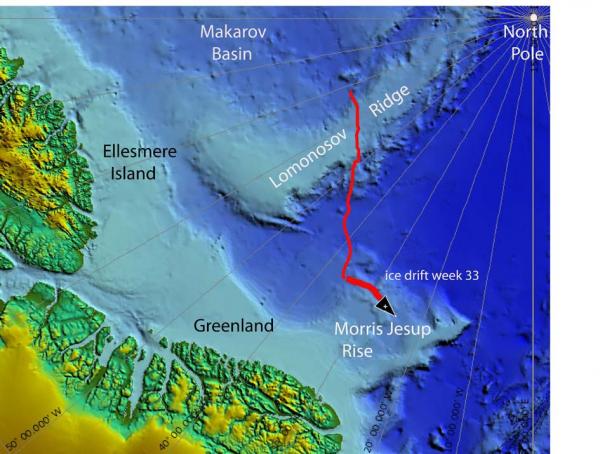
Fig. 1a. The drift of FRAM-2014/15 during week 33, 13 - 20 April 2015 (heavy red line). Thin red line indicates start of 570 km long seismic transect from the Makarov Basin to the Morris Jesup Rise.

Fig. 1b. Ice motion during the first part of week 33.

Fig. 2. Low pressure activity during week 33 ending with a stationary center at the North Pole for many days. Winds associated with a low pressure are parallel to the contours of equal pressure , anticlockwise with respect to the center and pointing slightly inwards.
Sea ice dynamics
No ice activity has been observed during the week in spite of wind speeds of 30-40 knot with gusts to over 50 knot during the weekend.
Camp life
The week has been mild with air temperatures in the range - 23° C to - 12° C . The arrival of the low pressure on Wednesday brought a warm spell where the temperature for six hours were as high as - 4° C. We devoted our time during the first part of the week to maintenance as the sea ice was not moving at all until Wednesday afternoon (Fig. 1b). The weather forecast told us about the arriving low pressure cell and immediate prospects of ice drift. It was time for the final break-through in the hydro hole to begin the seismic reflection measurements. The access hole in the ice is done by drilling many holes with a 10 cm diameter auger and then cut out ice blocks with a chain saw. As one gets deeper, the task gets more tedious (Fig. 4). It is desirable to make the remaining bottom layer only 10-15 cm thick and in the end cut through along the periphery as much as possible while the water level is rising in the hole.
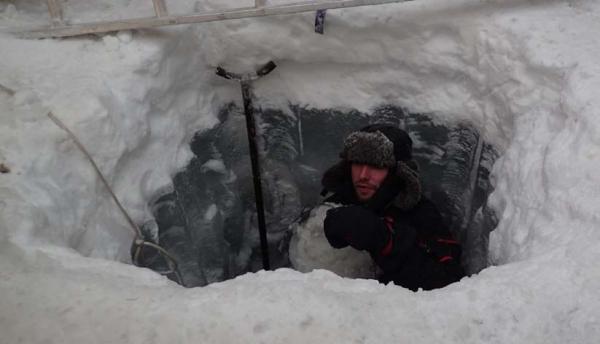
Fig. 4 Making the hydro hole. Ice thickness 1.8 meter.
The high winds associated with the low pressure cell started in the early hours of Saturday and remained steady over 30 knot with blowing snow (Fig. 5). We cleared snow from inside the work space once on Saturday, but gave up further upkeep until the weather improved.
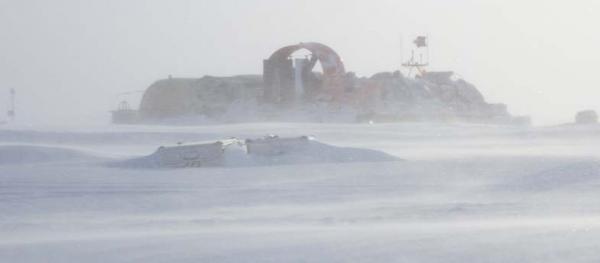
Fig. 5 A day with blowing snow
The visit by the P3 Orion of the 333 Squadron in excellent weather, provided an opportunity to get photographic overview of the ice situation around the camp (Fig. 6). We are surrounded by pressure ridges on three sides and in front of us is a newly refrozen lead. The sharp ridge behind the hovercraft is the collision zone and the leading edge of the smaller ice floe to the right. Our ice floe was over-ridden by the ice floe to the right and about 50 meter including our former camp area was forced under the floe. As a result, our camp area completely disappeared from the surface and the floe to the right has double thickness. You could feel what was going on by walking over the floe to the right when the ice activity occurred.
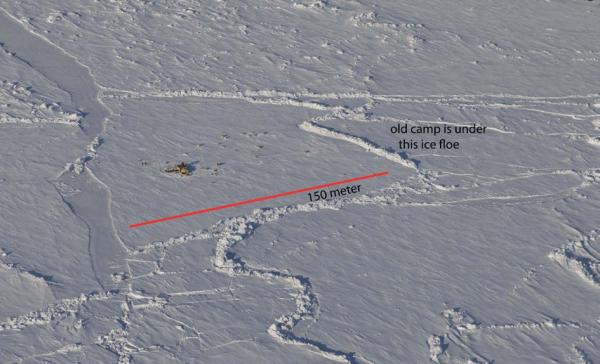
Fig. 6. Overview of the camp area. Photo courtesy of 333 Squadron, Norw. Air Force, Chief pilot Johan Erling Hætta.
Science
Underway continuous measurements:
Bathymetry and sub-bottom profiling:
- one autonomous echo sounder buoy reporting to shore via Iridium
- seismic data acquisition resumed on Sunday
Oceanography:
- one Aanderaa current meter at 800 meter depth.
Atmosphere:
- measurement of incoming and outgoing radiation from the ice surface
- surface infrared skin temperature
- sun time
- Aanderaa weather station
Station work
None.
The air gun was lowered into the new hydro hole on Sunday evening and seismic reflection measurements resumed after a four week break. To build a new camp took over a week and we had no ice drift during the last three weeks to make the seismic operation worthwhile. This is a restriction imposed by limited fuel reserves.
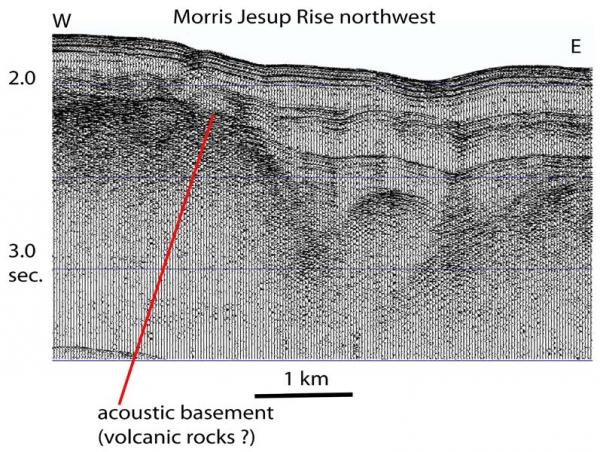
Fig. 7. Screen shot of seismic monitor with data from the northwest corner of Morris Jesup Rise.
The seismic section shows basement (volcanic+) topography buried and smoothed by sediments. Morris Jesup Rise along with the northeastern part of Yermak Plateau north of Svalbard are considered to be a result of local excessive volcanism in the time frame 50 to 40 million years ago. They later separated and continue to move apart by continental drift.
There has been no sign of animal life in our neighborhood during the week.
Life in the High Arctic is treating us well, and the arrival of new generators is part of that.
Yngve Kristoffersen & Audun Tholfsen
Daily reports
Monday 13 April
Position: 85° 16.4' N, 36° 11' W, temperature - 21° C, 1007 hPa, wind 4 knots from the NW. No ice drift. Audun went to look for bathymetry buoy # 1 and found it 4.7 km out from camp. Worked on the weekly report.
Tuesday 14 April
Position: 85° 16.4' N, 36° 12' W, temperature - 20° C, 1002 hPa, wind 7 knots from the NE. No ice drift. Checked the radiation flux instrument and removed snow from the IR sensor (up). Adapted the foot plate from the old winch to fit the new winch. Audun brought half a drum of Jet-A1 to camp. We also uncovered the sediment corers stored at the old camp. Our reserve of diesel is about 2.000 liters plus about 950 liter of Jet-A1 for heating.
Wednesday 15 April
Position: 85° 16.8' N, 36° 13' W, temperature - 17° C, wind 10 knots from the NE. Ice drift 0.1 knots to the NE. We received 3 cm of snow during the night. White-out all day. We had a warm spell in the late evening and early morning of the next day where the temperature reached - 4° C. Checked radiation flux instruments and removed snow from the IR (up) sensor. Discovered a leak in the radiator. After checking and consultation with Griffon Hoverworks, it was determined to be a leaking gasket between two sections of the radiator rather than frost damage to the cooling ribs. Put in a bar to better distribute the force from the bolts which are at 5 cm spacing. Prepared the camp for the coming high winds. Had the generator running most of the day to get hot water for a shower.
Thursday 16 April
Position: 85° 20.1' N, 37° 13' W, temperature - 12° C, air pressure 988 hPa, wind 5 knots from the NW.White-out all day. Ice drift 0.5 knot towards NW. We have moved 6.5 nautical miles to the NW during the night. Checked the radiation flux instruments and removed snow from the IR (up) sensor. A warm spell is here and we worked all day removing c. 2 cm thick layer of ice from the outer walls of the flotation tanks inside the cabin. Refilled some antifreeze and the radiator leak seem to be contained. We are running the Honda generator during the day and the main engine during the night for charging batteries.
Friday 17 April
Position: 85° 19.7' N, 35° 54' W, temperature - 23° C, pressure 994 hPa, wind 13 knots from the SW. Ice drift 0.5 knot towards E. Worked on the hydro hole to get the final break through at the bottom. The ice thickness is 1.8 meter. Also repaired the hydrophone cable - the first 6 meter of wire was broken several places and is not fit for the low temperature. The 333 Squadron has kindly made available video footage of the FRAM-2014/15 camp area to John K. Hall.
Saturday 18 April
Position: 85° 20.9' N, 33° 35' W, temperature - 20° C, ir pressure 995 hPa, wind 22 knots from the NW. Ice drift 0.4 knot towards E. The low pressure has arrived and we have a
snow storm - winds were gusting to 35-40 knots during the day. Cleared the work space for snow and tried to get seismic shooting going. The room was soon covered with a layer of snow inside and in the end we gave up to continue the work until the wind is down. Heating inside the hovercraft cabin suddenly stopped and the temperature inside went below + 10° C. Supply from the day tank must be clogged. Rigged a 20 liter diesel container inside until the weather is improved for outside work on the day tank.
Sunday 19 April
Position: 85° 21.2' air pressure 993 hPa,N, 30° 14' W, temperature - 15° C, wind 30-45 knots from the NW. Gusts to over 50 knots during the night. Ice drift 0.8 knot due E. The wind came down to 20-25 knot at noon. Started seismic shooting at 2200 hours.

